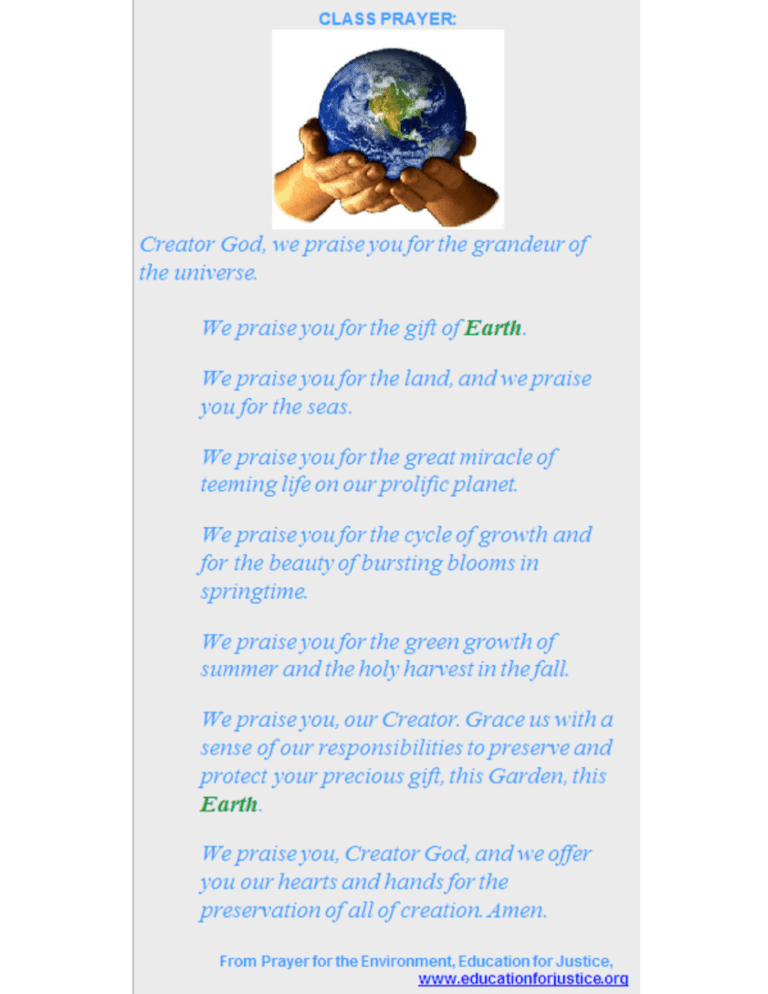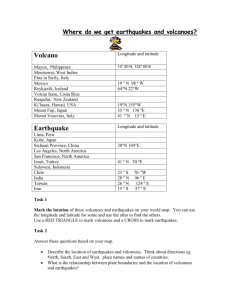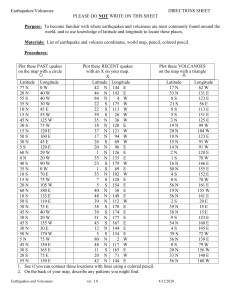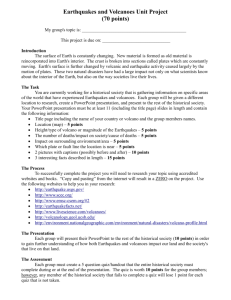latitude
advertisement

Let’s Review Our Homework Section 1 Review, page 181, #1 and 2 1. Where do most volcanoes occur on Earth’s surface? Most volcanoes occur along divergent plate boundaries, such as the mid-ocean ridge, or in subduction zones around the edges of the oceans. 2. What process forms island arcs? When converging plates collide, the older, denser plate dives under the other plate and sinks into the asthenosphere. There it melts and forms magma, which seeps upward, creating volcanoes that can result in an island arc. Mapping Earthquakes and Volcanoes Let’s apply what we know! In this investigation, we will… • Interpret data on the locations of earthquakes and volcanoes to find patterns. But First… What is the difference between latitude and longitude? Lines of Latitude are horizontal lines that measure North and South distances Lines of Longitude are vertical lines that measure East and West distances PROBLEM: Is there a pattern in the locations of earthquakes and volcanoes? Procedure • Use the table on page 182 to determine the latitude and longitude for earthquake and volcano locations • On a map of the United States, locate active volcanoes and areas of earthquake activity Earthquake and Volcano Latitude and Longitude Table (found on pg 182) Earthquakes Longitude 120° W 110° E 77° W 88° E 121° E 34° E 74° W 70° W 10° E 85° W 125° W 30° E 140° E 12° E 75° E 150° W 68° W 175° E 121° E Latitude 40° N 5° S 4° S 23° N 14° S 7° N 44° N 30° S 45° N 13° N 23° N 35° N 35° N 46° N 28° N 61° N 47° S 41° S 17° N Volcanoes Longitude 150° W 70° W 120° W 61° W 105° W 75° W 122° W 30° E 60° E 160° E 37° E 145° E 120° E 14° E 105° E 35° E 70° E 175° E 123° E Latitude 60° N 35° S 45° N 15° N 20° N 0° 40° N 40° N 30° N 55° N 3° S 40° N 10° S 41° N 5° S 15° N 30° S 39° S 13° N 3) 4) 2) 1) Use the information in the table to mark the location of each earthquake on the world map. Use one of the colored pencils to draw a letter “E” inside a circle at each earthquake location. Use a pencil of a second color mark the locations of the volcanoes on the world map. Indicate each volcano whit the letter “V” inside a circle Use a third pencil to lightly shade the areas in which earthquakes are found. Use a fourth colored pencil to lightly shade the areas in which volcanoes are found. Name:____________________ Date:__________ Class:________ 4) 3) 2) 1) How are earthquakes distributed on the map? Are they scattered evenly over Earth’s surface? Are they concentrated in zones? _____________________________________________________________________ _____________________________________________________________________ _____________________________________________________________________ How are volcanoes distributed? Are they scattered evenly or concentrated in zones? _____________________________________________________________________ _____________________________________________________________________ _____________________________________________________________________ From your data, what can you infer about the relationship between earthquakes and volcanoes _____________________________________________________________________ _____________________________________________________________________ _____________________________________________________________________ Based on the data, which area of the North American continent would have the greatest risk of earthquake damage? Of volcano damage? Why would knowing this information be important to urban planners, engineers, and builders in this area? _____________________________________________________________________ _____________________________________________________________________ _____________________________________________________________________ _____________________________________________________________________ _____________________________________________________________________ Analyze and Conclude – Use the table on page 182 and your map to answer the questions HOMEWORK • Finish your map and questions (to be collected on Friday, 1-13-11)







